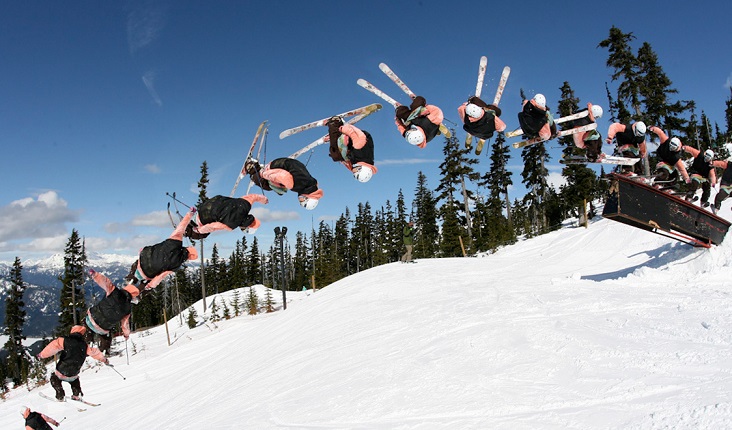
New York City architecture in 2013: The great and the not-so-great
In the spirit of the Olympics, here are our three favorite projects from 2013 — plus one that didn’t stick the landing.
A toast to 4 World Trade Center, Sunset Park’s new recycling center and Walker Tower, plus a hard look at Prospect Park’s new skating center.
This seems like a stretch to tie in architecture criticism to the Olympics, but it did get me to read the post by Matt Chaban of the Daily News. He brings his critique to a pedestrian level in my opinion, which is probably why I don’t know him as an architecture critic – that’s just my opinion. Do you agree with Matt’s Gold, Silver, and Bronze Medal projects? Do you have your own medals you would like to award?
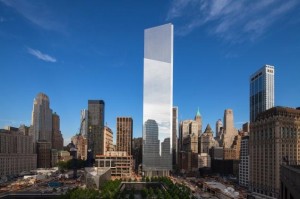
Gold medal
4 World Trade Center
It may not be the biggest building on the 16-acre site, nor the boldest, but it is certainly the most beautiful — a quiet, dignified tower that honors its sacred home. Using simple geometries, Japanese master architect Fumihiko Maki put a notched parallelogram atop a trapezoid and covered the whole thing in a crystalline glass sheath. The result is a solemn sentinel watching over the site.
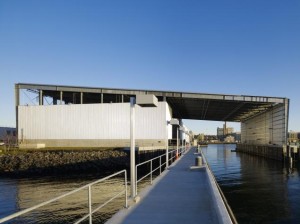
Silver medal
Sims recycling center
Annabelle Selldorf is best known for designing Fifth Ave. boutiques, Chelsea galleries and luxury apartments. And now a recycling plant in Sunset Park, Brooklyn (below). The firm used standard prefabricated beams and modules to create the hangar-like structure on the harbor. The surprisingly sleek industrial facility shows that simple components and a clever hand can achieve great results.
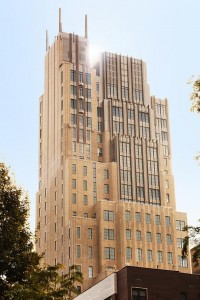
Bronze medal
Walker Tower
There’s a reason the wealthy and celebs like Cameron Diaz have been flocking to Walker Tower (right). Take a neglected art deco telephone exchange towering over Chelsea, gut it and turn it into a modern throwback. Period details and newfangled accessories are expensive, which explains why the penthouse is in contact for $50.9 million, a downtown record.
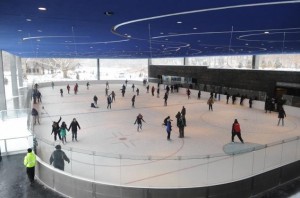
Dishonorable mention
Lakeside skating center
A good effort by Tod Williams and Billie Tsien, but the new skating center in Prospect Park (right) is more of an unpolished diamond — nice rinks, but utterly lacking in necessities like changing rooms and benches for hockey. We can only hope the problems will be addressed. By Matt Chaban
Architecture Criticism
|
4 World Trade Center, Annabelle Selldorf, architecture, design, Fumihiko Maki, Matt Chaban, Olympics, Prospect Park Skating Center, Sunset Park, Tod Williams and Billie Tsien, Walker Tower, WTC
|

It was once the polluted hotbed of the Industrial Revolution in London, a large area of land that became badly contaminated with toxic waste after centuries of abuse.
WATCH VIDEO
But the hope of the local Olympic organizers is that, what was once a wasteland site in Stratford, will soon bloom with fauna and wildlife as the green heart of the 2012 Games’ site.
The Olympic Delivery Authority (ODA) is planning to convert the area into Britain’s first new public park in London for over a century once the sporting event is over and — in order to create the intended environmental legacy — the work of planting, cultivating and remodeling the new landscape is already underway.
The Olympic Park will not only provide a public space for people to enjoy both during and after the Games, the aim is to generate a variety of habitats for wildlife with 2,000 trees and 350,000 wetland plants.
“There are all kinds of different habitats here and there are target species,” John Hopkins, a project sponsor for the parklands and public realm at the authority, told CNN. “We have things like the frog ponds, which hold water and have loggeries in them.
“We also have over 700 wildlife installations. We have wet woodland, which is a very rare habitat that feeds off the river to keep it wet.”
Wetland areas have been central to the regeneration of the area, specifically along the banks of the River Thames, which runs from the UK’s east coast and through the heart of the British capital.
“This is part of a huge vision for restoring working landscapes in the whole of the Thames gateway, which is great for bio-diversity and great for people,” Hopkins said.
“Parks like this create those places where people want to live, work and play.”
Turning the former industrial area into a suitable home for plants and animals has not been a straightforward process.
Factories had been located on the site in the 18th and 19th centuries, which left the soil in need of special treatment.
“This site was one of the crucibles of the Industrial Revolution in London,” Hopkins said. “Some of the land was heavily contaminated after centuries of abuse.
“We had what we called ‘soil hospitals.’ They were treating all of the materials to make sure that it was suitable for re-use on the site.”
Paul de Zylva, head of international environmental organization Friends of the Earth has been working on the issue of the Games coming to London since 2003, two years prior to the city being awarded the Olympics.
He told CNN he was generally supportive of the work being done by the ODA.
“The plan they have come up with is about trying to create some of the old London habitat that used to exist there,” said Da Zylva. “Grasslands, meadows, woodland and waterways as well, and I think that’s been done well.
“They are putting in a long-term management plan for the area. There’s a 10-year management plan for the park, which is a good start.
“They are trying to manage the land to be of high conservation value, to the point where some parts of it would be on the way to being designated as a site of special scientific interest, which is the highest possible designation in this country. So that’s a good ambition.”
De Zylva also praised the honesty of London’s organizers with regards to making information about the Games available.
“We said to them that we do want you to be open and transparent about what the impact of putting on the Games would be, and they published that.
“We were very pleased they did. We think it’s important, if you’re going to learn lessons from staging the Games, that you have a baseline of information about what it actually takes to host the Olympics.
“This is the first time it has been done, London has been good in that respect.”
London has held the Summer Olympics on two previous occasions, in 1908 and 1948 — next year’s event will begin with the opening ceremony on July 27 and conclude on August 12.
Source: CNN
Thanks to writer Julie V. Iovine and the folks at The Architects Newspaper, I came across this project. It looks fantastic and I would love to see it built. Although I admit I am not so sure I would ever reach the top to put my head in the “clouds”. My fear of heights and intended airy and light feel of the structure might stand in my way. This of course assumes I ever travel to London.

A proposal spearheaded by MIT's Senseable City Lab envisions an inhabitable sculpture for London's 2012 Olympics.
All Photos Courtesy Raise the Cloud
In early November, British architects discovered with dismay that Mayor Boris Johnson of London was conducting a secret competition to select a designer for a $33 million beacon for the 2012 Olympics. Brushing aside the standard procurement process—which involves publishing a notice in The Official Journal of the European Communities—Johnson invited 30 firms to submit proposals for a prominent addition to the city’s skyline.

A Guggenheim-like spiral wrapped in cable netting will support the clouds, with much of the structure open to the public.
Called “the Cloud,” the structure starts with a slender spire that is ringed by a spiraling ramp, stabilized with a cable net, and sturdy enough for strollers and bicyclists to mount to a sky full of bubbly spheres. This upper aerie would host three types and sizes of spheres: The largest and most structural are Buckminster Fuller–type geodesic domes; next, cable-net bubbles would cluster around observation decks; and then, blurring the edge, bunches of hot-air-filled balloons create that head-in-the-clouds feeling.
The EFTE inflatables would be covered in a new type of distributed LED that is readable from any direction and could provide a constant stream of information, including game statistics, weather forecasts, traffic advisories, alien greetings, and presumably, advertisements.

Olympic visitors at play in "the Clouds."
Intended to stand 400 feet tall, the Cloud will barely have a footprint, sustainability-wise. Photovoltaic film, whose effect will be magnified by mirrors, is spread over the spheres. And while visitors can only ascend the one-kilometer ramp on foot or by bicycle, they can descend by means of a “regenerative lift” that uses the same braking system as a Prius to recoup electricity, as will water-wheels embedded in the column through rain collection.
The exact size of the Cloud remains to be determined. Taking a page from the grassroots innovations of the Obama campaign, the team has organized a structure that can expand or contract depending on donations. The density of the cloud cover—the number of spires and individual clouds, in fact—will depend on how many people sign on to contribute.

London Mayor Boris Johnson envisions a beacon for the Olympics, and mit's is only one of several proposals thought to be under consideration.
While the contenders—said to include Foreign Office Architecture—have yet to be named, one team is already spreading the word about their entry on Facebook. Carlo Ratti, architect and director of MIT’s SENSEable City Lab, joined forces with German engineer Joerg Schlaich, Arup, artist Tomas Saraceno, corporate sponsor Google UK, and others to create what Ratti described as “not a building for London but a symbol of global ownership.”
The Facebook page Raise the Cloud was launched on November 11 with 1,000 fans and counting, according to Ratti, who would like to see as many as three spires covered in clouds at the as-yet-unselected site. “We can build our Cloud with five million pounds or 50 million,” he said. “The flexibility of the structural system will allow us to tune the size of the Cloud to the level of funding that is reached.” Whether or not selected by Mayor Johnson to be the official 2012 Olympic Tower, the Cloud is certain to attract plenty of air time.
aia, architect, architects, architecture, architecture critic, buildings, carbon-neutral office building, construction, Design, eco building, Engineering, green building, modern architecture, new buildings
|
ARUP, Buckminster Fuller, Carlo Ratti, geodesic domes, Hot Air Balloons, Joerg Schlaich, Julie V. Iovine, London Olympic Tower, Mayor Johnson, MIT, MIT’s SENSEable City Lab, Olympics, Photovoltaic, The Architects Newspaper, The Cloud, The Official Journal of the European Communities, Tomas Saraceno
|

















